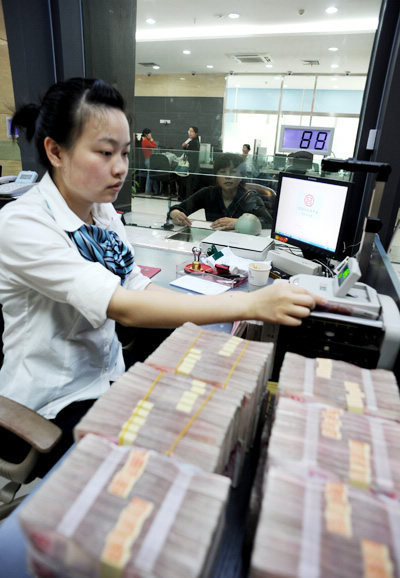|
 |
|
COUNTING GAME: A bank clerk counts banknotes in the Yiwu Branch of the Industrial and Commercial Bank of China in east China's Zhejiang Province (ZHANG JIANCHENG) |

China's central bank cut interest rates for deposits and loans and adjusted their floating ranges on June 8. Yi Xianrong, a research fellow with the Institute of Finance and Banking under the Chinese Academy of Social Sciences, shared his views on the impact of the cut with Shanghai Securities News. Edited excerpts follow:
The People's Bank of China, the central bank, just took a major step in the market-oriented reform of interest rates, but it's difficult to say how far the government can go with the reform.
The central bank cut deposit and lending interest rates by 0.25 percentage points and extended the floating range of the rates, in the hope of curbing the downward trend in economic growth. This is a strong signal to the market: The government is resolute in maintaining stable economic growth.
The purpose
But the interest rate cut is far beyond market expectations. For one thing, it's the first time the central bank adjusted the floating range for deposit and lending rates, which indicates the likely cyclical turns in the country's monetary policy and an important step in its market-oriented reform of interest rates. For another, in its first-quarter monetary policy report released in April, the central bank said it preferred quantitative instruments rather than price ones to meet the liquidity demands of the real economy, and hoped to bring money supply and credit growth to normal through pre-emptive adjustments and fine-tuning of the monetary policy. Given the current economic climate, the GDP growth decline was one of the macro-control targets, and the fall in the growth of consumer price index (CPI) suggested residents' deposit interest rates are getting out of the negative territory.
When the April statistics were published, the government began to fine-tune economic policies to stabilize growth. Then, the market expected the central bank to loosen the monetary policy as soon as possible to reduce downside risks to economic growth. In such a context, preceding the release of May statistics, the central bank decided to resort to price instruments by lowering deposit and lending rates, responding to the requirement of stabilizing growth, as well as mustering up courage to revitalize domestic economic development.
Despite increasingly severe downside risks to economic growth, there is no reason for the cyclical turns of the monetary policy. In fact, the GDP growth dip is part of the expected outcome of the government's macro-control policies. To solve the major contradictions in economic development and secure sustainable and stable economic growth in the mid- and long-term, adjustments need to be made in industrial structure and economic strategies, reducing the overdependence on the real estate industry. In this sense, economic growth slowdown seems inevitable.
Under the current circumstances, the decline of CPI growth cannot give rise to cyclical turns of the central bank's monetary policy. There is no denying that the fall in CPI growth leaves more space for the central bank to cut interest rates, but in the past decade, Chinese residents deposit their money at negative interest rates, so if the bank cuts interest rates once they become positive, its intention will be evident.
|
